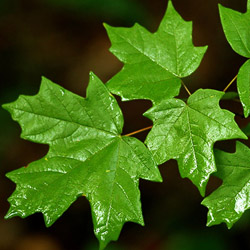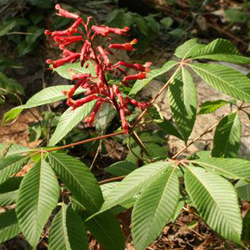Family Profile: The Sapindaceae
By Emily Barnes and Dan Moore
This
post is one of a series from professor Nisse Goldberg's Plant Taxonomy
students at Jacksonville University. FNPS blogger Laurie Sheldon
assisted the students with their initial drafts, providing suggestions
for editing and content development.
 |
| Figure 1. Acer saccharum ssp. floridanum, FL sugar maple. Photo credit: Michael Drummond. |
Plant
Sex:
Bisexual (ex: Bligia sapida) or
unisexual (ex: Litchi chinensis)
Flowers: Radial to bilateral, with a nectar disk usually present
Fruits: Loculicidal and septicidal capsules (ex: Bilia columbiana), berries (ex: Litchi chinensis), samaras (ex: Acer rubrum), and schizocarps (ex: Dipteronia sinensis)
Leaves: Alternate or opposite; pinanately or palmately compound, trifoliate or unifoliate
Flowers: Radial to bilateral, with a nectar disk usually present
Fruits: Loculicidal and septicidal capsules (ex: Bilia columbiana), berries (ex: Litchi chinensis), samaras (ex: Acer rubrum), and schizocarps (ex: Dipteronia sinensis)
Leaves: Alternate or opposite; pinanately or palmately compound, trifoliate or unifoliate
 |
| Figure 2. Aesculus pavia (red buckeye) flowers are popular with hummingbirds and butterflies. Photo credit: Shirley Denton. |
Description
Sapindaceae
is commonly referred to as the “soapberry family” and includes trees, shrubs,
and lianas. Serjania is the largest genus of the Sapindaceae, which
includes 215 species. Species in this family are largely found in Asia and
America, specifically in tropical to subtropical regions.
In
Florida, the Sapindaceae has14 representative native species within 8 distinct genera, including maples (fig. 1), buckeyes or horse-chestnuts (fig. 2), and soapberries (fig. 3).
• Sapindus
saponaria
can be used as soap. (This explains the common name for the family, “soapberry”).
By crushing the berries to get to the saponin, Native Americans and early
settlers were able to make soap and other cleansers.
• Schleichera
trijuga
produces macassar oil, which can be used in ointments.
• Paullinia cupana produces
guarana, a potable liquid. Brazilians are known to be very fond of drinking guarana! It can
also be found in Rockstar and Redbull energy drinks.
• Blighia sapida contains
an edible aril which can be poisonous if eaten during the wrong
stage of ripeness! People of West Africa are known to eat this fruit.
• Melicocca bijuga is harvested
for its tasty Spanish lime in South America.
References
Judd, WS, Campbell, SC, Kellogg, EA, Stevens, PF, and Donoghue, ML. 2008. Plant systematics: A phylogenetic approach. Sinauer Associates, Inc. Massachusetts, USA
http://www.fao.org/docrep/005/ac681e/ac681e04.htm
http://www.plantbiology.siu.edu/PLB304/Lecture19Fagal/Sapindaceae.html
http://personal.denison.edu/~hauk/biol320/sapindaceae.html
http://florida.plantatlas.usf.edu/Family.aspx?id=297
http://www.thewildclassroom.com/biodiversity/floweringplants/Sapindaceae.htm
http://www.fao.org/docrep/005/ac681e/ac681e04.htm
http://www.plantbiology.siu.edu/PLB304/Lecture19Fagal/Sapindaceae.html
http://personal.denison.edu/~hauk/biol320/sapindaceae.html
http://florida.plantatlas.usf.edu/Family.aspx?id=297
http://www.thewildclassroom.com/biodiversity/floweringplants/Sapindaceae.htm
Image sources




Comments
Western soapberry (Sapindus saponaria var. drummondii) is not a plant that is common to Florida - it is found in the southwestern U.S. and Mexico. Wingleaf soapberry (Sapindus saponaria var saponaria) or Florida soapberry (Sapindus marginatus) are its closest Florida relatives. Check with https://www.plantant.com/ or http://plantrealflorida.org/ for availability.